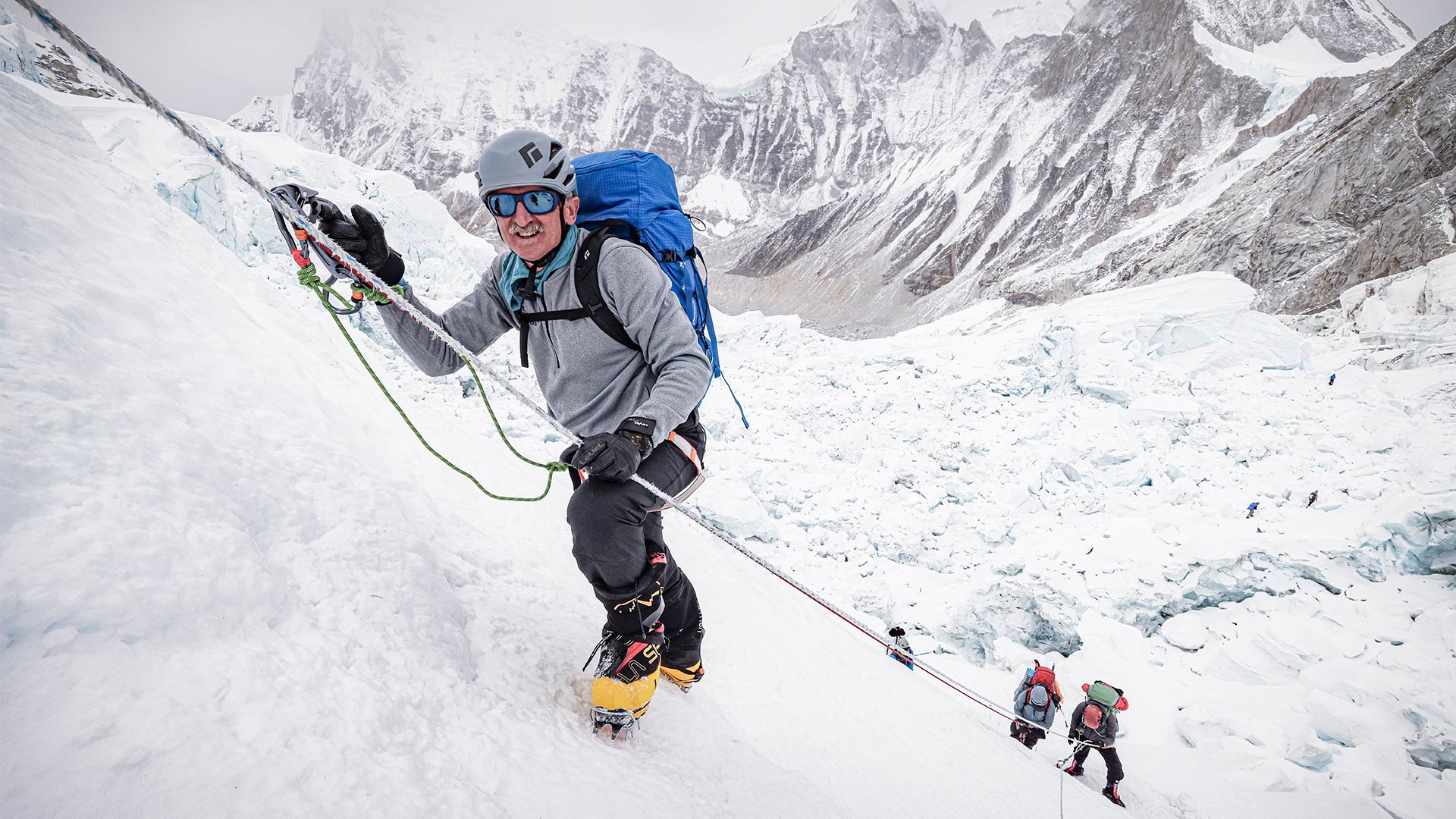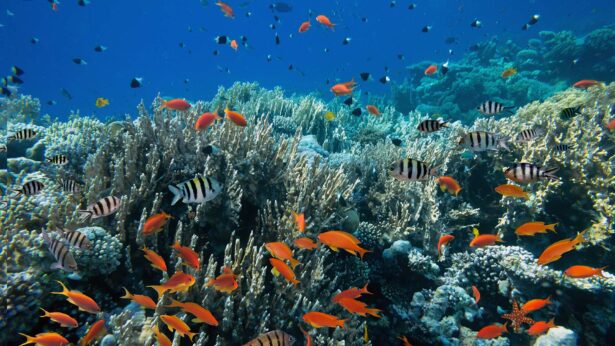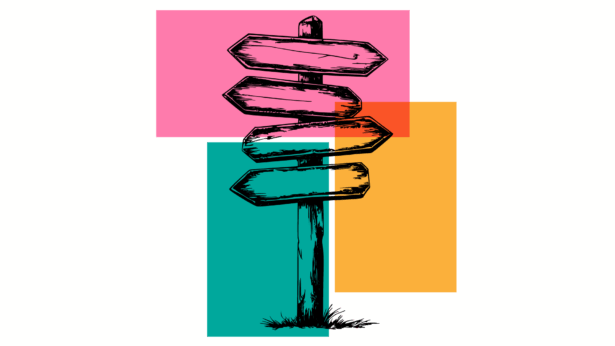Listen to this story
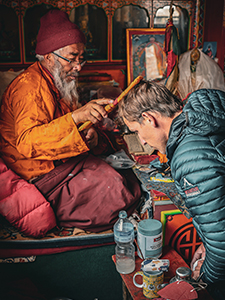
Bryan Hill knelt before the Buddhist monk as the monk prayed a blessing for safe passage and then firmly tied a necklace of narrow red string with two knots around his neck and those of the others pursuing a dream up a mountain. Hill, like other hikers, planned to wear that prayer of protection until it fell off months or even a year in the future.
But first, Hill (Knoxville ’08) would be part of a team guiding blind Navy veteran Lonnie Bedwell up the mountain known as Chomolungma, “Goddess Mother of the World,” in Tibetan or Sagamatha, “Peak of Heaven,” in Sanskrit.
In English, it’s known as Mount Everest.
After a weather delay of more than two weeks, on May 16, 2023, Hill, Bedwell and a third member of their team, Michael Neal, left Everest Base Camp and began the trek up the world’s highest peak. Hill slid his glove up the rope and took a step while pausing three to four seconds to catch his breath. He called out directions for Bedwell, “Hey Lonnie, foot is going to go up and out to the right 3 inches.”
The correct instructions and the trust could mean the difference between life and death, especially through the Khumbu Icefall, which is crisscrossed with crevasses hundreds of feet deep and littered with seracs, ice blocks the size of houses that can tumble downward with little warning. The icefall remains in constantly changing slow motion, creeping down the mountain at the rate of up to 4 feet each day.
Corpses unable to be removed from the mountain remind the living that this mountain kills.
The Trek
For the three men, their climb really began 26 years before. After serving in the Navy from 1985 to 1994, Bedwell served in the National Guard for three years. That service ended when, on a turkey-hunting trip with a friend, the friend accidentally blinded him with a shotgun blast to the face. Bedwell learned how to mow, cut wood and even build houses without sight.
Fourteen years after the accident, Bedwell went to a blind rehabilitation center in Chicago, and his next life began. Therapists asked Bedwell if he would like to learn to ski to prove to blind veterans that an active life is still possible. That led to other adventures, including being the first blind person to kayak down the Colorado River through the Grand Canyon. For a man who had no interest in extreme adventure before the accident, it became his calling to show blind veterans that their best lives can still be before them.
“This is my next duty assignment,” Bedwell says. “This is my next mission. This is a way I can continue to give back.”
On such an assignment hiking Mount Aconcagua in Argentina, Bedwell met Neal. When Neal and Hill, who had become friends while on a hiking trip in California, hiked to Mount Everest Base Camp in 2021, they saw a blind hiker preparing to make his ascent. Neal remembered meeting Bedwell and his mission. The two men decided to call Bedwell with a proposition using the Wi-Fi at base camp.
When Bedwell heard the men’s idea for him to climb Mount Everest, he hung his head. A few days prior, the executive director of the Blinded Veterans Association had requested Bedwell include them on his next adventure. Bedwell said he would, but he had no plans for one.
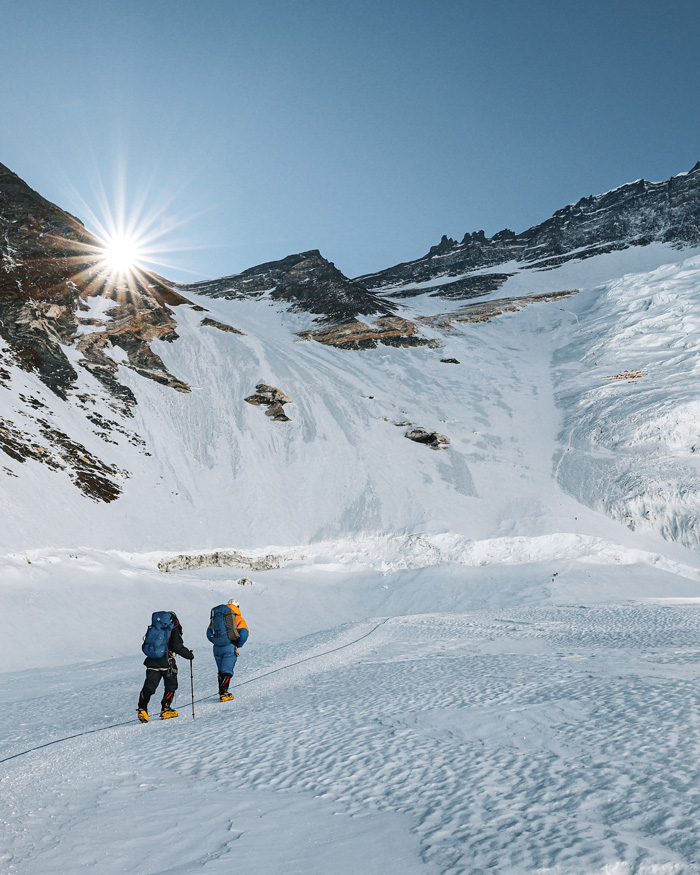
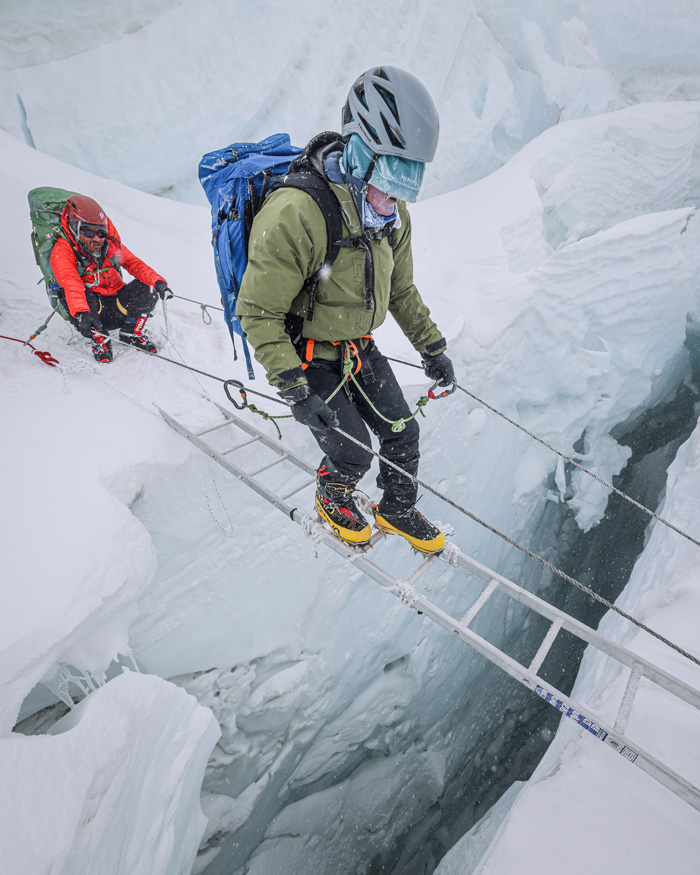
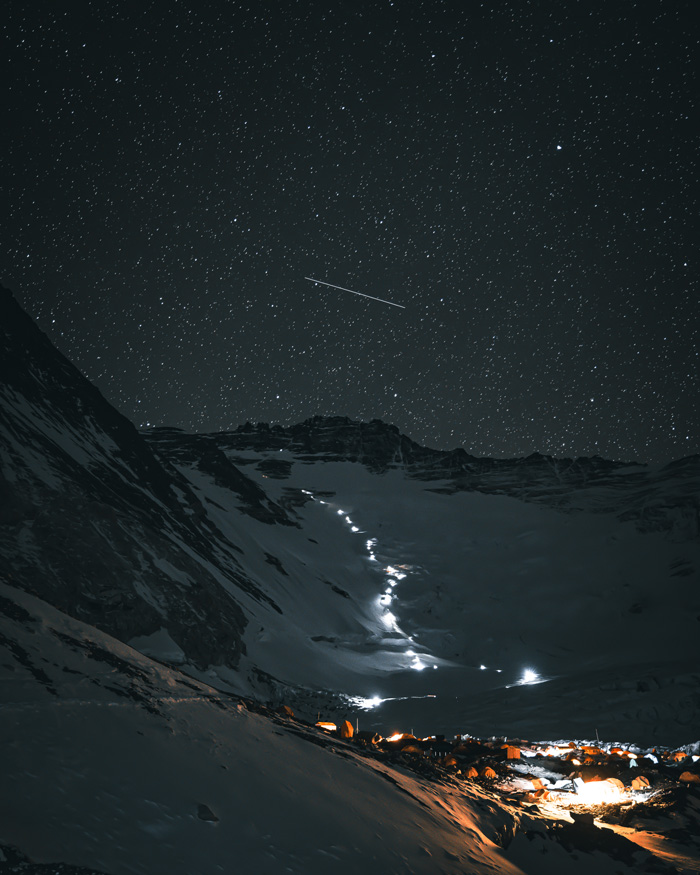
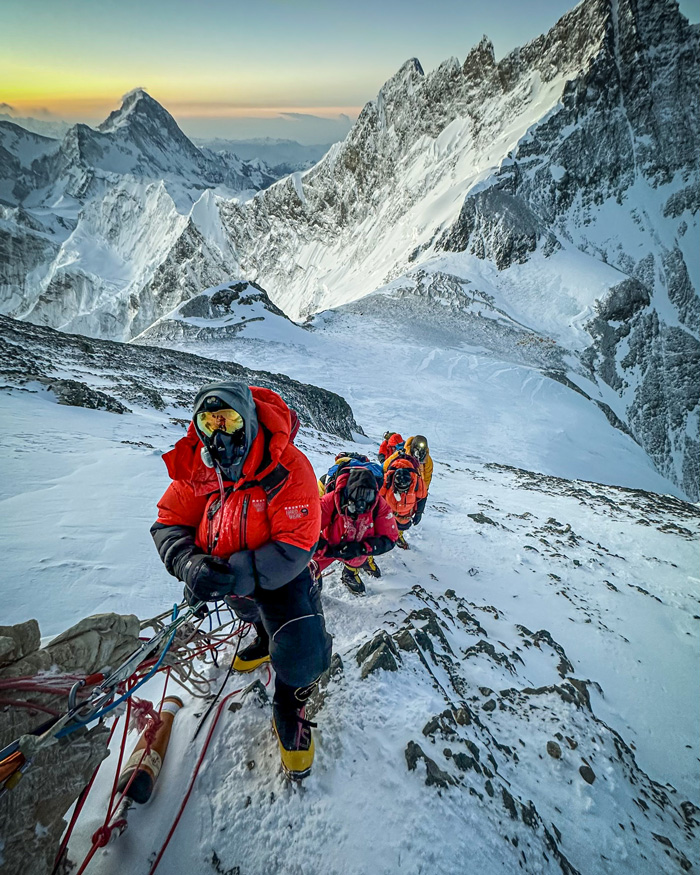
CLICK TO EXPAND IMAGES
“I just lowered my head,” Bedwell says when Hill and Neal called him. “I had no desire to ever do this.”
But he didn’t hesitate to agree.
“In my mind, it was like, ‘It’s meant to be.’”
The trio of men decided to go beyond just climbing Mount Everest. They created the Sightless Summits organization and established a goal to complete the Explorers’ Grand Slam, which would mean climbing the highest peak on each continent and skiing to each pole. No blind person has completed it.
Hill—a Knoxville native, avid hiker and climber, and a certified strength and conditioning specialist—works as a physical therapist in Santa Cruz, California. He often sees people in dark places, struggling to find their identities again after an amputation or stroke or major life event.
“I think our message is that life is still out there,” he says. “It might look a little different than what it looked like before, but you are still able to do so much. It’s going to look a little different, and you’ll have to adapt, but so much is still possible if you let go of this pride and step forward into the new life.”
Bedwell agrees.
“None of us have ever gotten anywhere in life without somebody helping us, teaching us, guiding us along the way, believing in us, giving us a chance,” he says.
Bedwell would need to rely on Hill, Neal and others to guide him through dangerous heights to reach others in soul darkness and pull them toward the light of hope.
The Ascent
With experience climbing Mount Kilimanjaro in Africa and Aconcagua in South America, Bedwell had some experience with extreme climbing. But he would need to discover if he could hike well with Hill and Neal. In 2022, the team traveled to Denali in Alaska. Roped together with three other men, Bedwell listened closely to their footsteps to determine steps and snow thickness. He listened to their directions on where to place his feet while navigating with two trekking poles. He concentrated on what he was hearing and what he felt under his feet.
“I can’t just take a step and it not be a meaningful step,” he says.
“No matter how confident he is with what we tell him, there’s a question in his mind as he’s stepping down, ‘Will it hold or will it not?’” Hill says.
Two hours into the hike, the men told Bedwell to take a step to the right. He did—and fell into a crevasse. Tied together, the men arrested Bedwell’s fall with rope that connected them and then pulled him up. Hill, Neal and the others looked at each other, wondering if Bedwell would continue or if they had lost his trust.
Bedwell continued.
“These guys, they’ve got me,” he says.
They proved it again while climbing Mount Everest.
To reach the base of the mountain, Hill and Neal met in Bakkhali, India, on the Indian Ocean, and they rode bicycles about 650 miles across the country to the border with Nepal, where they were detained for 10 hours. The two men had unknowingly traveled through a region known for a far-left radical communist group at war with the Indian government.
“We were told by locals that they cannot believe we were not captured and held for ransom or killed,” Hill says. “We rode through Islamic, Buddhist and Hindu communities and really were only treated with warmth and compassion.”
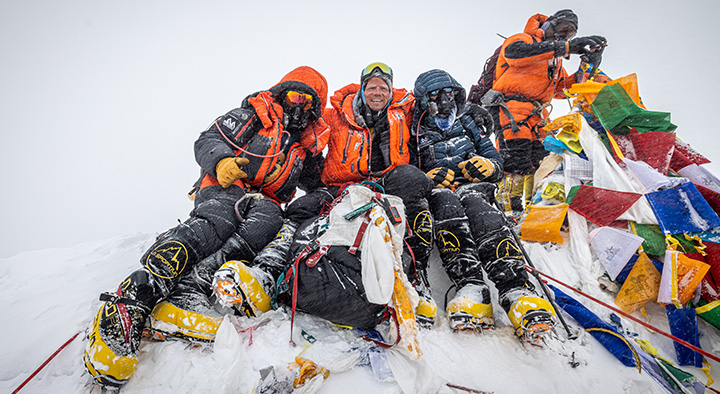
The men met up with Bedwell in Kathmandu, then began their journey to Heaven’s Peak.
After two acclimation hikes and 15 days of weather delays, the men set out from Everest Base Camp about 2 a.m. to begin the multi-day climb of 12.5 miles to the 29,032-foot summit. They would use oxygen to combat the thin atmosphere, which only has one-third of the oxygen at sea level.
The first day they traversed the Khumbu Icefall, where three sherpas had already died that year when a serac tumbled down. Slowly they made their way up the south flank of the mountain and reached Camp IV, in what is known as the Death Zone, on May 21. The next morning they would begin the final ascent.
In the early-morning hours on May 22, they began. Hour after hour they continued to make their way step by step, clipped to a safety line strung along the route. They crossed the 50-degree slope of rocky Summit Ridge, passing the body of a hiker who had died years before—the bodies of more than 280 climbers who have died remain on the mountain. Above the Summit Ridge as they navigated Hillary Step, Neal slipped and fell. His rope clipped to the safety line caught him.
They continued on.
Seventeen hours after they started, at about 4:15 p.m., as strong winds and snow rolled across the peak with minus 40-degree temperatures, they reached the top. They stopped for a photo among the Tibetan prayer flags that mark the top. There they also discovered that Bedwell’s oxygen mask wasn’t working properly, which had severely limited his oxygen intake for hours, exhausting him further.
“We were excited to be there, but it was also a bit of a tense moment because we still have to descend 3,000 feet. We know we’re going to be going down in the dark,” Hill says. “There’s a lot of joy, but in the back of your mind, you know this isn’t over yet.”
The Descent
On the way down, Bedwell discovered the sherpa with his water and snacks had gone ahead. He would need them to make it down the mountain. Hill left the rest of the team to catch the sherpas and managed to do so about halfway down in an area called The Balcony. There he waited for Bedwell and the rest of the team. Cold crept into Hill’s feet, and his right foot began to hurt.
After giving the food and water to Bedwell, Hill raced down the mountain to Camp IV. He knew something wasn’t right with his foot, but after 21 hours of hiking, Hill didn’t want to look at it when he reached his tent. The next day, he saw two blisters on his second toe, which was rigid and painful to the touch. Their guide diagnosed it as stage 2 frostbite.
Mount Everest Facts
29,032 feet
12.5 miles from Everest Base Camp to summit
11,332 feet elevation gain from base camp to summit
Edmund Hillary and Tenzing Norgay were the first to summit on May 29, 1953.
2023 Statistics
600 people summited
(350 sherpas supporting 250 clients)
57% of people successfully summited
18 climbers died
Lonnie Bedwell–fourth blind person to summit
Explorers’ Grand Slam
Since 1998, about 70 people have accomplished this feat.
North Pole
South Pole
Denali—North America
Mount Aconcagua—South America
Mount Vinson—Antarctica
Mount Elbrus—Europe
Mount Kilimanjaro—Africa
Mount Everest—Asia
Carstensz Pyramid—Oceania

Hill still had to get down off the mountain. They bandaged it and began their descent to Camp II. Hill’s foot began to refreeze, and the pain grew more intense. By the time they reached Camp II, the blister had grown, and his toe was turning black.
A helicopter picked Hill up from Camp II, and through a series of relays, he was flown to Kathmandu, where a doctor informed him that his toe would need to be amputated. He had the middle section of his toe removed later when he returned to the United States.
“I felt horrible,” Bedwell says. “He lost part of his toe to go get the water so I could safely make it down the mountain.”
“I’d do it again, Lonnie,” Hill replied when Bedwell tried to discuss it with him.
Hill remembers taking off his summit suit in his tent after his race down the mountain and finding the red string, which the lama had tied on him three weeks before, had come off with the suit, landing on the tent floor.
“It was like maybe someone or something was watching and keeping us safe,” he says.
